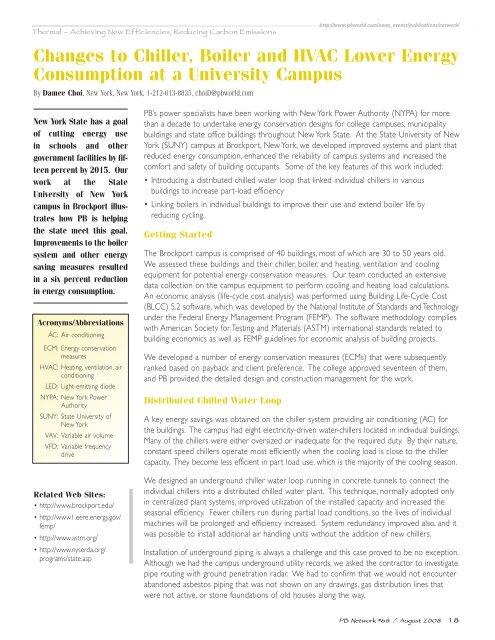Innovation in Global Power - Parsons Brinckerhoff
Innovation in Global Power - Parsons Brinckerhoff
Innovation in Global Power - Parsons Brinckerhoff
You also want an ePaper? Increase the reach of your titles
YUMPU automatically turns print PDFs into web optimized ePapers that Google loves.
Thermal – Achiev<strong>in</strong>g New Efficiencies, Reduc<strong>in</strong>g Carbon Emissions<br />
http://www.pbworld.com/news_events/publications/network/<br />
Changes to Chiller, Boiler and HVAC Lower Energy<br />
Consumption at a University Campus<br />
By Damee Choi, New York, New York, 1-212-613-8835, choiD@pbworld.com<br />
New York State has a goal<br />
of cutt<strong>in</strong>g energy use<br />
<strong>in</strong> schools and other<br />
government facilities by fifteen<br />
percent by 2015. Our<br />
work at the State<br />
University of New York<br />
campus <strong>in</strong> Brockport illustrates<br />
how PB is help<strong>in</strong>g<br />
the state meet this goal.<br />
Improvements to the boiler<br />
system and other energy<br />
sav<strong>in</strong>g measures resulted<br />
<strong>in</strong> a six percent reduction<br />
<strong>in</strong> energy consumption.<br />
Acronyms/Abbreviations<br />
AC: Air condition<strong>in</strong>g<br />
ECM: Energy conservation<br />
measures<br />
HVAC: Heat<strong>in</strong>g, ventilation, air<br />
condition<strong>in</strong>g<br />
LED: Light-emitt<strong>in</strong>g diode<br />
NYPA: New York <strong>Power</strong><br />
Authority<br />
SUNY: State University of<br />
New York<br />
VAV: Variable air volume<br />
VFD: Variable frequency<br />
drive<br />
Related Web Sites:<br />
• http://www.brockport.edu/<br />
• http://www1.eere.energy.gov/<br />
femp/<br />
• http://www.astm.org/<br />
• http://www.nyserda.org/<br />
programs/state.asp<br />
PB’s power specialists have been work<strong>in</strong>g with New York <strong>Power</strong> Authority (NYPA) for more<br />
than a decade to undertake energy conservation designs for college campuses, municipality<br />
build<strong>in</strong>gs and state office build<strong>in</strong>gs throughout New York State. At the State University of New<br />
York (SUNY) campus at Brockport, New York, we developed improved systems and plant that<br />
reduced energy consumption, enhanced the reliability of campus systems and <strong>in</strong>creased the<br />
comfort and safety of build<strong>in</strong>g occupants. Some of the key features of this work <strong>in</strong>cluded:<br />
• Introduc<strong>in</strong>g a distributed chilled water loop that l<strong>in</strong>ked <strong>in</strong>dividual chillers <strong>in</strong> various<br />
build<strong>in</strong>gs to <strong>in</strong>crease part-load efficiency<br />
• L<strong>in</strong>k<strong>in</strong>g boilers <strong>in</strong> <strong>in</strong>dividual build<strong>in</strong>gs to improve their use and extend boiler life by<br />
reduc<strong>in</strong>g cycl<strong>in</strong>g.<br />
Gett<strong>in</strong>g Started<br />
The Brockport campus is comprised of 40 build<strong>in</strong>gs, most of which are 30 to 50 years old.<br />
We assessed these build<strong>in</strong>gs and their chiller, boiler, and heat<strong>in</strong>g, ventilation and cool<strong>in</strong>g<br />
equipment for potential energy conservation measures. Our team conducted an extensive<br />
data collection on the campus equipment to perform cool<strong>in</strong>g and heat<strong>in</strong>g load calculations.<br />
An economic analysis (life-cycle cost analysis) was performed us<strong>in</strong>g Build<strong>in</strong>g Life-Cycle Cost<br />
(BLCC) 5.2 software, which was developed by the National Institute of Standards and Technology<br />
under the Federal Energy Management Program (FEMP). The software methodology complies<br />
with American Society for Test<strong>in</strong>g and Materials (ASTM) <strong>in</strong>ternational standards related to<br />
build<strong>in</strong>g economics as well as FEMP guidel<strong>in</strong>es for economic analysis of build<strong>in</strong>g projects.<br />
We developed a number of energy conservation measures (ECMs) that were subsequently<br />
ranked based on payback and client preference. The college approved seventeen of them,<br />
and PB provided the detailed design and construction management for the work.<br />
Distributed Chilled Water Loop<br />
A key energy sav<strong>in</strong>gs was obta<strong>in</strong>ed on the chiller system provid<strong>in</strong>g air condition<strong>in</strong>g (AC) for<br />
the build<strong>in</strong>gs. The campus had eight electricity-driven water-chillers located <strong>in</strong> <strong>in</strong>dividual build<strong>in</strong>gs.<br />
Many of the chillers were either oversized or <strong>in</strong>adequate for the required duty. By their nature,<br />
constant speed chillers operate most efficiently when the cool<strong>in</strong>g load is close to the chiller<br />
capacity. They become less efficient <strong>in</strong> part load use, which is the majority of the cool<strong>in</strong>g season.<br />
We designed an underground chiller water loop runn<strong>in</strong>g <strong>in</strong> concrete tunnels to connect the<br />
<strong>in</strong>dividual chillers <strong>in</strong>to a distributed chilled water plant. This technique, normally adopted only<br />
<strong>in</strong> centralized plant systems, improved utilization of the <strong>in</strong>stalled capacity and <strong>in</strong>creased the<br />
seasonal efficiency. Fewer chillers run dur<strong>in</strong>g partial load conditions, so the lives of <strong>in</strong>dividual<br />
mach<strong>in</strong>es will be prolonged and efficiency <strong>in</strong>creased. System redundancy improved also, and it<br />
was possible to <strong>in</strong>stall additional air handl<strong>in</strong>g units without the addition of new chillers.<br />
Installation of underground pip<strong>in</strong>g is always a challenge and this case proved to be no exception.<br />
Although we had the campus underground utility records, we asked the contractor to <strong>in</strong>vestigate<br />
pipe rout<strong>in</strong>g with ground penetration radar. We had to confirm that we would not encounter<br />
abandoned asbestos pip<strong>in</strong>g that was not shown on any draw<strong>in</strong>gs, gas distribution l<strong>in</strong>es that<br />
were not active, or stone foundations of old houses along the way.<br />
PB Network #68 / August 2008 18

















